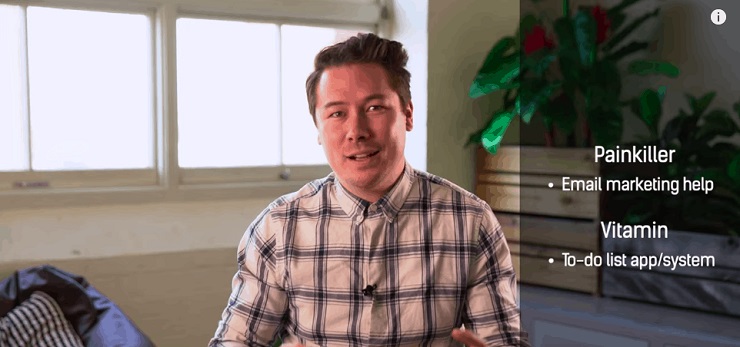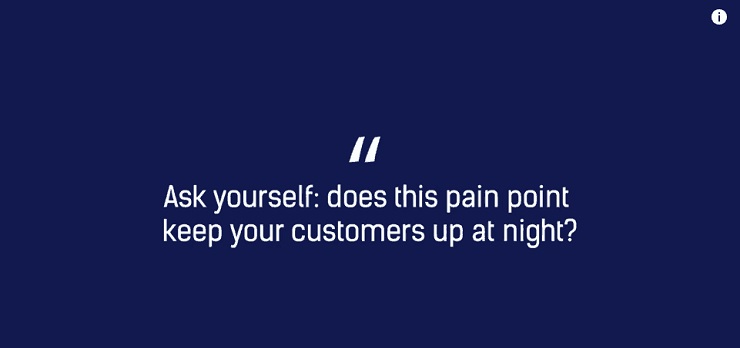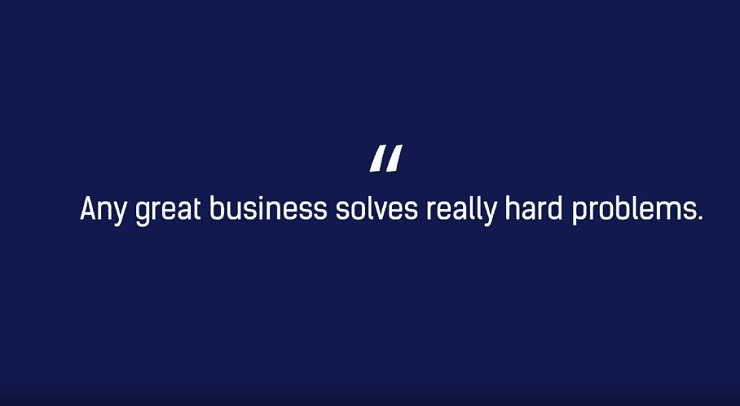Raise your hand if you’ve ever forgotten to take your vitamins, or if you never take vitamins at all. Now, when’s the last time you had a painful headache and forgot to take the right pills to make it go away?
When something is good for us, we may or may not take it. But when we’re in pain, we grasp at anything that can ease it.
This simple truth is what you should be thinking about when you create a product: Is it a vitamin (a nice-to-have) or a painkiller (a must-have)?
To help you understand the difference, we’ve got Foundr’s founder Nathan Chan. Check out the video below and then keep scrolling to learn more details on how to identify customer pain points and make more sales.
“You don’t want to be creating subpar content or product or putting out ideas into the marketplace that really don’t hit a nerve,” Nathan says.
That means it’s not enough to create a quality product or one that people think is nice. You need to create a product that your customers need, one that relieves their pain.
A focus on solving pain points is how Foundr comes up with our own content and course ideas. But like many businesses, we didn’t get this at first.
“To be honest with you guys,” Nathan says, “we’ve launched some products at Foundr, and we’ve put out some content, that no one gives a crap about.”
Harsh words, but true. So how can you make sure you create a painkiller instead of a vitamin?
Painkillers vs. Vitamins: Examples of Products
When you’re trying to figure out how to find customer pain points, it can help to look at some examples. Below are two examples that show the difference between a painkiller product and a vitamin product.
Painkiller: Email Marketing Help
This is a huge pain point in the entrepreneurial space. Business owners need to know how to boost their email marketing metrics, how to get more opens, clicks, and conversions, and ultimately, more sales. So to relieve this pain point, Foundr produced a course on advanced email marketing.
Vitamin: To-Do List App or System
Along the same vein, a vitamin product in the entrepreneur space would be a to-do list app or a new kind of system to create your to-do list. This would be a vitamin because it’s just a nice-to-have. Entrepreneurs are not experiencing deep pain over how they’re writing out their tasks for the day. That’s because it’s not directly related to boosting sales for their business.
Now, let’s take a look at an example of painkiller versus vitamin in the personal finance space.
Painkiller: Debt Relief
Whether it’s from credit cards or student loans, having debt is incredibly painful. (Who likes owing people money?!) So a painkiller product here would be one that teaches or helps people to get out of debt.
Vitamin: Travel Hacking
Figuring out how to get free perks while traveling is pretty sweet—but it’s not a deeply painful problem.
“It’s a first-world problem if you have to worry about using points and gaming the system and getting free flights or upgrades,” Nathan says.
Once again, this is a nice-to-have product, but it doesn’t help someone in a big way. If a person’s already privileged enough to be flying somewhere, upgrading to business or first class isn’t something they’re going to lose sleep over.
If you want to distinguish between a painkiller versus a vitamin while you’re generating product ideas, ask yourself this question: Does this pain point keep my customers up at night?
When businesses fail, Nathan believes it’s because they’re creating products or services that people don’t actually care about. “The market decides what is going to succeed,” he says.
That’s why, when you develop a product, you need to create a painkiller product that is fully validated. And sometimes, it’s not always clear whether you have a painkiller or a vitamin. Often, an entrepreneur has a product that makes a few sales, but they’re spending so much money trying to get more sales.
How can you tell if you’re selling a painkiller (a product that solves customer pain points) or a vitamin (a product that is nice for your customers to have)?
How to Find Customer Pain Points
If you want your product to fly off the shelves, it’s important to know how to find customer pain points. Here are some ways to do just that.
Comb Through Existing Data
If you’re already in business, even if you’ve got a failing product, you’re actually in a good position because you have valuable data. Take advantage of existing data to glean insights about customer pain points. You could start with:
- Customer support emails
- Online reviews
- Social media comments and posts
- Talking to your sales team and customer support reps
Ask Your Customers
Survey or interview your existing customer base to find out what their pain points are. Even if your current product isn’t resolving them, you can always create new products that will.
To survey your audience, try these tools:
When surveying your customers, it’s essential to read between the lines and find the things they aren’t telling you. For example, a potential client might come to me and say they need to hire a freelance writer to help them create blog content. But that’s not what they really need. If I continue to probe, I might find out that the potential client needs blog content because they’re wasting money on ads and are hoping to use SEO instead to get more traffic to their site. And they need more traffic to their site because they need visitors to opt in to their email sales funnel. And they need more opt-ins to their email sales funnel because they make money by selling online courses to their email list.
The worst question you could possibly ask your customers is some variation of this: “If we made [product], would you buy it?” It’s the worst question because the answers you get are meaningless. Many people will say they would buy your product, but at the end of the day, it’s their actions that count. That’s why product validation is so important.
Validate Your Product Idea
You know we here at Foundr are always telling you to validate, validate, validate—and for good reason! The true test of whether your product is a painkiller or a vitamin is to validate it, which means finding out if people are interested before you potentially waste time and money creating the product. So while people may say they’ll buy your product, it all comes down to whether or not they actually hit that purchase button.
There are many ways to validate a product idea, including:
Bottom line: Before you create a product, make sure enough people will buy it.
Research Competing Products
It may seem counterintuitive, but to achieve product/market fit, enter a space where there are already competitors who are succeeding. That’s because if they’re successful, it’s a good market. All you have to do now is find out where your competitors are failing to resolve customer pain points and be the one to create a solution that outperforms existing products. You don’t need to be first, you just need to be better.
As Andrew Chen of Andreessen Horowitz writes:
Google was not the first search engine, Facebook was not the first social network, and Microsoft was not the first OS.
However, those companies came to dominate those markets because they came in early, when the dynamics were still developing. And the markets grew and grew.
Start on Amazon. Find existing products that are bestsellers, and then comb through the reviews. Pay special attention to the 3-, 2-, and 1-star reviews. Find out where these best-selling products are failing. You’ll learn about the customer pain points that are going unresolved. Then, you’ll be armed with the information you need to create a better product than anything that currently exists in the market.
So if you can find successful products, that means those businesses have already found customer pain points. If you want to beat out the competition, you need to find a way to improve upon existing products to better resolve those pain points.
Find a Pain Point in Your Own Life
Many companies started this way: A regular person finds a problem, creates a solution for themselves, realizes other people have the same problem, and then starts a successful business sharing that solution with others.
Just look at Daisy Jing of Banish. She struggled with acne since her childhood and started a YouTube channel to share her journey. Fed up with prescriptions and harsh chemicals that didn’t work, Jing started mixing her own all-natural acne treatments at home. When her YouTube viewers started commenting on how much better her skin looked, she knew she was onto something. She founded Banish, an ecommerce store that makes millions in revenue per year selling natural skincare products.
If All Else Fails, Pivot
Finally, if you find that your current product isn’t solving your customers’ pain points, rather than scrapping your business altogether, consider pivoting. Some of the most successful companies did just that.
PayPal, for example, pivoted five times in 15 months. What started as a way to “beam” payments from one Palm Pilot to another ended up being a beloved solution for eBay users because it solved pain points: Small sellers were finally able to accept online payments, and buyers were able to purchase online without sharing their credit card information with strangers.
Need another real-life example? Werk started as a way to help women find flexible jobs, so they had a job board. But after about a year and a half in business, they pivoted to a people analytics platform on a mission to help everyone achieve more flexibility in their careers. In an announcement on why they were getting rid of their job board, founders Annie Dean and Anna Auerbach wrote:
In early 2018, we realized that companies’ biggest barrier to succeeding at flexibility was a lack of data. In response, we released a people analytics platform to measure companies’ flex performance and guide them toward a more modern employee experience.
In other words, they found the real customer pain point was not a lack of flexible job listings but a lack of data for companies on how they could improve work flexibility. So instead of a job board, Werk created a people analytics platform.
As you can see, even if you have a vitamin product now, that doesn’t mean you can’t create a painkiller product later. Look at this as an opportunity to discover what your real customer pain points are and head in a new direction from there.
What’s Your Painkiller?
By now, I hope you realize that a painkiller product will beat out a vitamin product anytime. And to create a painkiller, you just need to know how to find customer pain points.
To recap, here are the steps we went over:
- Comb through existing data
- Ask your customers
- Validate your product idea
- Research competing products
- Find a pain point in your own life
- Pivot if you need to
As Nathan says in his video: “Any great business solves really, really hard problems.”
Now, get out there and solve the really hard problems!
What’s your painkiller product? Share it in the comments below!























